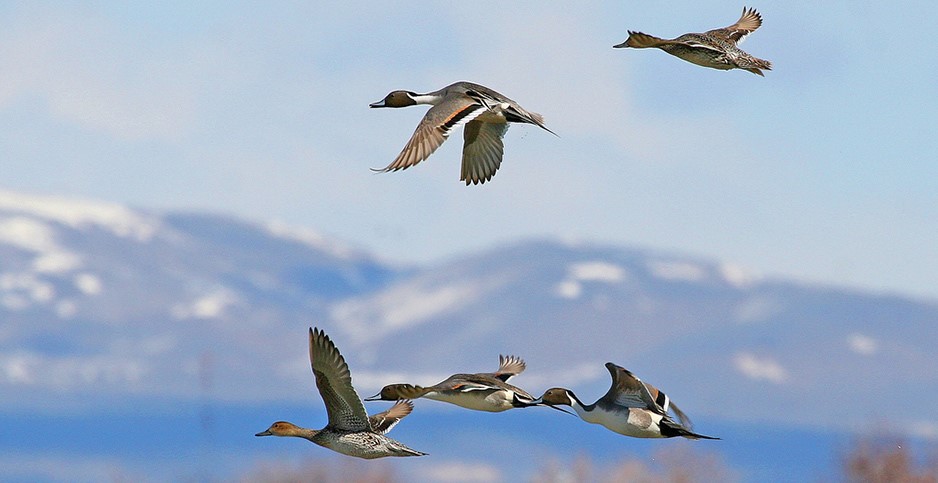A federal court has struck down the Trump administration’s revisions to migratory bird regulations. J. Kelly/Fish and Wildlife Service/Flickr The Trump administration’s controversial approach to migratory bird safeguards runs afoul of the law, a federal judge ruled yesterday. The U.S. District Court for the Southern District of New York struck down the Interior Department’s 2017 interpretation of the Migratory Bird Treaty Act (MBTA) that removed penalties for activities or hazards, such as power line electrocutions, that result in the accidental taking of a bird.
“It is not only a sin to kill a mockingbird, it is also a crime,” wrote Judge Valerie Caproni, citing a famous excerpt of the 1960 novel “To Kill a Mockingbird.” “That has been the letter of the law for the past century. “But if the Department of the Interior has its way,” she continued, “many mockingbirds and other migratory birds that delight people and support ecosystems throughout the country will be killed without legal consequence.”
Interior Solicitor General Daniel Jorjani wrote in a 2017 legal opinion that “[i]nterpreting the MBTA to apply to incidental or accidental actions hangs the sword of Damocles over a host of otherwise lawful and productive actions” (E&E News PM, Dec. 22, 2017). Caproni, an Obama appointee, scrapped the Jorjani opinion and remanded the issue to Interior. “Yesterday’s opinion undermines a commonsense interpretation of the law and runs contrary to recent efforts, shared across the political spectrum, to decriminalize unintentional conduct,” said department spokesman Conner Swanson.
The court decision strands one of Interior’s most controversial moves, as the department has been seeking to solidify the now-rejected solicitor’s opinion as a formal rule (Greenwire, July 20). “With the legal basis for its actions over the past year defeated, the administration should expect more defeats in court if they try to lock in their attempt to roll back the MBTA,” said Sarah Greenberger, interim chief conservation officer for the National Audubon Society, one of the challengers in the case.
Eight states that had also thrown their weight behind the lawsuit celebrated Caproni’s decision. “Migratory birds, including the bald eagle, are not only national symbols of freedom and liberty — they are vital for our country’s ecosystem,” said California Attorney General Xavier Becerra (D). “Today’s decision recognizes the critical importance of protecting our precious wildlife and upholding the rule of law.”
If the Trump administration appeals, as would be likely for such a high-stakes defeat, the case could be on track for the Supreme Court because of a potential split in how different appellate circuits have interpreted the law’s ambiguous language. Impact on rulemaking The proposed regulation now under review would codify the opinion of the Interior solicitor’s office that incidental bird take resulting from an otherwise lawful activity is not prohibited under the MBTA. Bird mortality estimates vary widely. The number of birds killed annually by power pole electrocutions, for instance, is figured at between 900,000 and 11.6 million. Collisions with wind turbines currently kill an estimated 234,000 birds per year, while oil pits kill an estimated 750,000 birds annually.
In a regulatory impact analysis that accompanied the proposed rule, FWS reported it had pursued an average of 57 incidental take cases annually between 2010 and 2018. Eighty-one percent of the cases were brought against electrical or oil and gas businesses. Four percent of the cases were brought against wind energy companies. “A legal opinion of the Department of the Interior does not provide the public or other federal departments and agencies with the certainty of a codified regulation,” a draft environmental impact statement (EIS) explained. The draft EIS was the subject of a boisterous public comment period that expired July 20. The Fish and Wildlife Service has said a final rule could be expected in the fall. The draft EIS said narrowing MBTA protections would have a “likely negative” impact on birds that includes “increased” mortality. The draft EIS further predicted that “some entities” such as energy companies will “likely reduce” compliance with industry standards designed to protect birds. Other non-avian species and certain cultural resources are also said in the draft EIS to face “likely negative” consequences from the narrower protections. Companies, though, could anticipate “likely reduced legal and financial costs” with the certainty they won’t be prosecuted for actions that inadvertently lead to the deaths of migratory birds, according to the federal agency. “For some industries and some practices, there would likely be cost savings from not implementing beneficial practices,” the study predicted.


